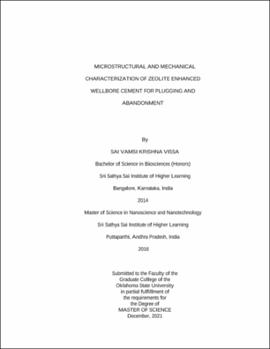| dc.contributor.advisor | Radonjic, Mileva | |
| dc.contributor.author | Vissa, Sai Vamsi Krishna | |
| dc.date.accessioned | 2022-05-13T19:37:22Z | |
| dc.date.available | 2022-05-13T19:37:22Z | |
| dc.date.issued | 2021-12 | |
| dc.identifier.uri | https://hdl.handle.net/11244/335808 | |
| dc.description.abstract | Major technological improvements have been seen in the drilling and completions of oil and gas wellbores, to enable safer exploration and production of fossil fuels. On the other hand, plugging and abandonment (P&A) of these wellbores have not seen the same amount of development. Off shore wellbores face various challenges in the case of P&A as they need to maintain complete zonal isolation. With almost 281 kilotons of methane released every year from 3.2 million abandoned wells, it is crucial to reduce the leakage of hydrocarbons from a global warming perspective. In order to prevent these risks, P&A of these wellbores calls for the usage of advanced materials which have exceptional sealing and zonal isolation properties apart from high strength and resilience. These should be comparable to the natural cap rocks which sustain the harsh sub-surface conditions like High temperatures and pressures for thousands of years. Portland cement (Class-H) based seals are currently used, still face many problems like degradation and failure causing a disruption in their sealing property. This work includes the literature survey studying the research that was done to arrive at an ideal additive material for class-H cement. Zeolite had been studied as an additive to cement showing improvement in cement properties which are discussed in the coming chapters. The addition of zeolites had shown an improvement in various cement properties as observed in the literature. A zeolite ferrierite had been adapted from the geothermal application. 5% by weight of cement ferrierite added cores had shown improvement of properties like UCS by about 41% in comparison to neat Class-H cement-based cores. It had also shown an improvement in triaxial strength tests with a 68.8MPa peak stress shown for 5% ferrierite compared to 62.9MPa for neat Class-H cement. petrophysical property improvement had been seen for 5% ferrierite addition as it had the lowest permeability of 13.54uD which is lower than that of neat Class-H cement (49.53 uD). The results of 15%, as well as 30% additions, had been reported in this work and the overall performance makes it a contender for our application in P&A. | |
| dc.format | application/pdf | |
| dc.format | application/vnd.ms-excel | |
| dc.format | image/jpeg | |
| dc.format | image/png | |
| dc.language | en_US | |
| dc.rights | Copyright is held by the author who has granted the Oklahoma State University Library the non-exclusive right to share this material in its institutional repository. Contact Digital Library Services at lib-dls@okstate.edu or 405-744-9161 for the permission policy on the use, reproduction or distribution of this material. | |
| dc.title | Microstructural and mechanical characterization of zeolite enhanced wellbore cement for plugging and abandonment | |
| dc.contributor.committeeMember | Ley, Tyler | |
| dc.contributor.committeeMember | Al Dushaishi, Mohammed | |
| dc.contributor.committeeMember | Capraz, Ozgur | |
| osu.filename | Vissa_okstate_0664M_17512.pdf | |
| osu.accesstype | Open Access | |
| dc.type.genre | Thesis | |
| dc.type.material | Text | |
| dc.type.material | Dataset | |
| dc.type.material | Image | |
| dc.subject.keywords | cement | |
| dc.subject.keywords | petroleum engineering | |
| dc.subject.keywords | plugging and abandonment | |
| dc.subject.keywords | supplementary cementitious materials | |
| dc.subject.keywords | wellbore cements | |
| dc.subject.keywords | zeolites | |
| thesis.degree.discipline | Petroleum Engineering | |
| thesis.degree.grantor | Oklahoma State University | |




